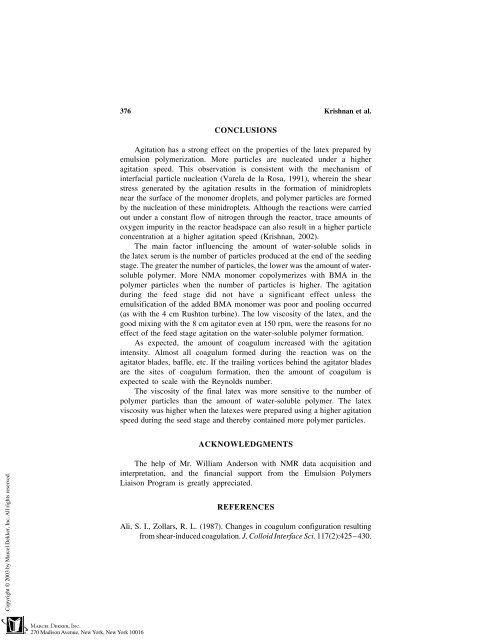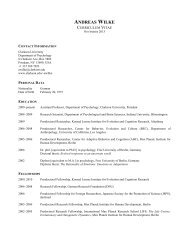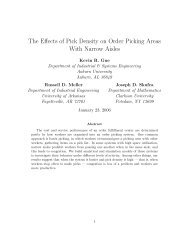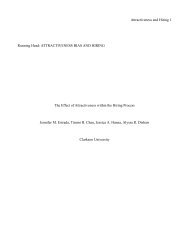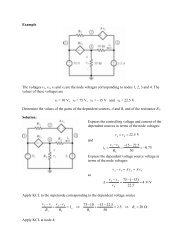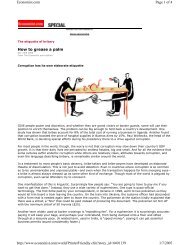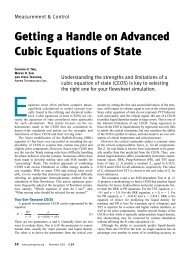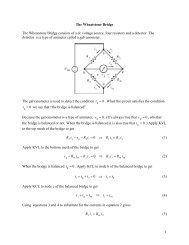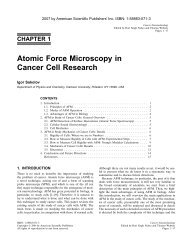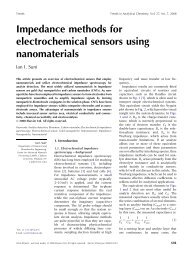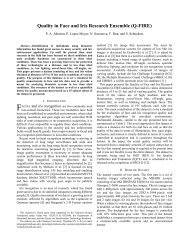Relative Importance of the Effects of Seed and Feed Stage ...
Relative Importance of the Effects of Seed and Feed Stage ...
Relative Importance of the Effects of Seed and Feed Stage ...
Create successful ePaper yourself
Turn your PDF publications into a flip-book with our unique Google optimized e-Paper software.
376 Krishnan et al.<br />
CONCLUSIONS<br />
Agitation has a strong effect on <strong>the</strong> properties <strong>of</strong> <strong>the</strong> latex prepared by<br />
emulsion polymerization. More particles are nucleated under a higher<br />
agitation speed. This observation is consistent with <strong>the</strong> mechanism <strong>of</strong><br />
interfacial particle nucleation (Varela de la Rosa, 1991), wherein <strong>the</strong> shear<br />
stress generated by <strong>the</strong> agitation results in <strong>the</strong> formation <strong>of</strong> minidroplets<br />
near <strong>the</strong> surface <strong>of</strong> <strong>the</strong> monomer droplets, <strong>and</strong> polymer particles are formed<br />
by <strong>the</strong> nucleation <strong>of</strong> <strong>the</strong>se minidroplets. Although <strong>the</strong> reactions were carried<br />
out under a constant flow <strong>of</strong> nitrogen through <strong>the</strong> reactor, trace amounts <strong>of</strong><br />
oxygen impurity in <strong>the</strong> reactor headspace can also result in a higher particle<br />
concentration at a higher agitation speed (Krishnan, 2002).<br />
The main factor influencing <strong>the</strong> amount <strong>of</strong> water-soluble solids in<br />
<strong>the</strong> latex serum is <strong>the</strong> number <strong>of</strong> particles produced at <strong>the</strong> end <strong>of</strong> <strong>the</strong> seeding<br />
stage. The greater <strong>the</strong> number <strong>of</strong> particles, <strong>the</strong> lower was <strong>the</strong> amount <strong>of</strong> watersoluble<br />
polymer. More NMA monomer copolymerizes with BMA in <strong>the</strong><br />
polymer particles when <strong>the</strong> number <strong>of</strong> particles is higher. The agitation<br />
during <strong>the</strong> feed stage did not have a significant effect unless <strong>the</strong><br />
emulsification <strong>of</strong> <strong>the</strong> added BMA monomer was poor <strong>and</strong> pooling occurred<br />
(as with <strong>the</strong> 4 cm Rushton turbine). The low viscosity <strong>of</strong> <strong>the</strong> latex, <strong>and</strong> <strong>the</strong><br />
good mixing with <strong>the</strong> 8 cm agitator even at 150 rpm, were <strong>the</strong> reasons for no<br />
effect <strong>of</strong> <strong>the</strong> feed stage agitation on <strong>the</strong> water-soluble polymer formation.<br />
As expected, <strong>the</strong> amount <strong>of</strong> coagulum increased with <strong>the</strong> agitation<br />
intensity. Almost all coagulum formed during <strong>the</strong> reaction was on <strong>the</strong><br />
agitator blades, baffle, etc. If <strong>the</strong> trailing vortices behind <strong>the</strong> agitator blades<br />
are <strong>the</strong> sites <strong>of</strong> coagulum formation, <strong>the</strong>n <strong>the</strong> amount <strong>of</strong> coagulum is<br />
expected to scale with <strong>the</strong> Reynolds number.<br />
The viscosity <strong>of</strong> <strong>the</strong> final latex was more sensitive to <strong>the</strong> number <strong>of</strong><br />
polymer particles than <strong>the</strong> amount <strong>of</strong> water-soluble polymer. The latex<br />
viscosity was higher when <strong>the</strong> latexes were prepared using a higher agitation<br />
speed during <strong>the</strong> seed stage <strong>and</strong> <strong>the</strong>reby contained more polymer particles.<br />
ACKNOWLEDGMENTS<br />
The help <strong>of</strong> Mr. William Anderson with NMR data acquisition <strong>and</strong><br />
interpretation, <strong>and</strong> <strong>the</strong> financial support from <strong>the</strong> Emulsion Polymers<br />
Liaison Program is greatly appreciated.<br />
REFERENCES<br />
Ali, S. I., Zollars, R. L. (1987). Changes in coagulum configuration resulting<br />
from shear-induced coagulation. J. Colloid Interface Sci. 117(2):425–430.


